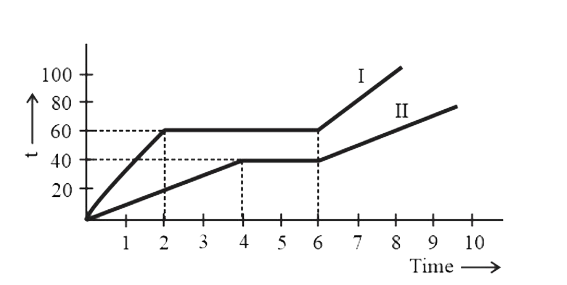Two bodies A and B of equal masses are supplied with equal amountt of heat energy. If rise in temperature of A is more than that in B, what is the relation between their specific heats?
For body A, Q=m×sA×ΔθA (1)
and for body B, Q=m×sB×ΔθB (2)
Dividing (1) by (2)SASB=ΔθBΔθA
This shows that specific heat is inversely proportional to rise in temperature. Thus, specific heat of A is less than that of B.
Similar Questions
Two bodies A and B of equal masses are supplied with equal amountt of heat energy. If rise in temperature of A is more than that in B, what is the relation between their specific heats?
View SolutionTwo bodies of differet metals A and B having an equal mass are given equal quantities of heat. Given that the molecular weight of A is greater than that of B, compare the specific heat capacities of the two metals. (Note that the rise in temperature is a measure of the increase in the average kinetic energy of the molecules.).
View Solution
Knowledge Check
Two bodies A and B having same initial tempera ture are supplied with same current of heat. The final temperature of A is more than that of B, then
Aspecific heat capacity of A is higher than BBspecific heat capacity of B is higher than ACthermal capacity of A is higher than BDthermal capacity of B is higher than ATwo bodies A and B are of same mass and same amount of heat is given to both of them .
If the temperature of A increases more than that of B because of heat addition ,thenAthe specific heat capacity of A is more than that of BBThe specific heat capacity of A is less than that of BCBoth A and B have the same specific heat capacity but A has greater thermal conductivityDBoth A and B the same specific heat capacity but B has greater thermal conductivity .Two bodies of equal masses are heated at a uniform rate under identical conditions. The change in temperature in the two cases is shown graphically. The ratio of their specific heats in the solid state is
 A1:3B1:2C2:1D1:4
A1:3B1:2C2:1D1:4
Two bodies of differet metals A and B having an equal mass are given equal quantities of heat. Given that the molecular weight of A is greater than that of B, compare the specific heat capacities of the two metals. (Note that the rise in temperature is a measure of the increase in the average kinetic energy of the molecules.).
View SolutionEstablish relation between two principle specific heats of a gas.
View SolutionEqual masses of oxygen and helium gases are supplied equal amount of heat. Which gas will undergo a greater temperature rise and why?
View Solutiontwo bodies A and B of equal masses are kept at heights of h and 2h respectively. What will be the ratio of their potential energies ?
View SolutionA and B are two bodies. The temperature of A is greater than that of B. The heat will flow from:
View Solution
